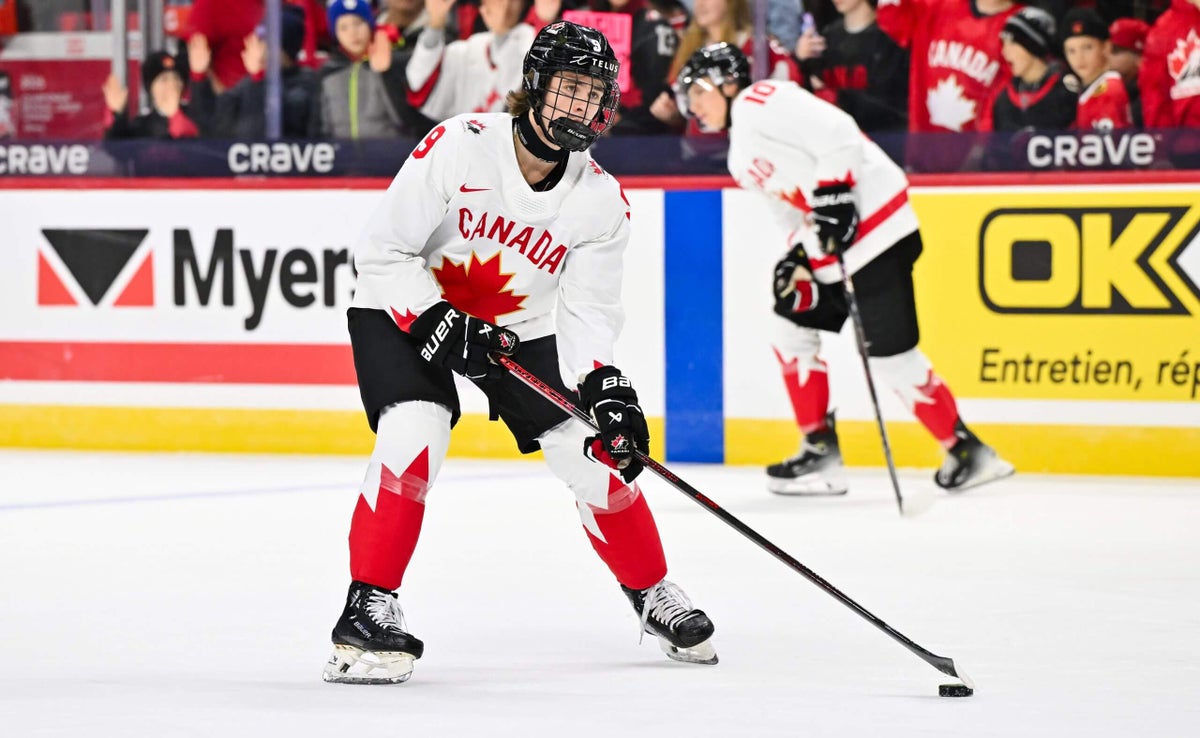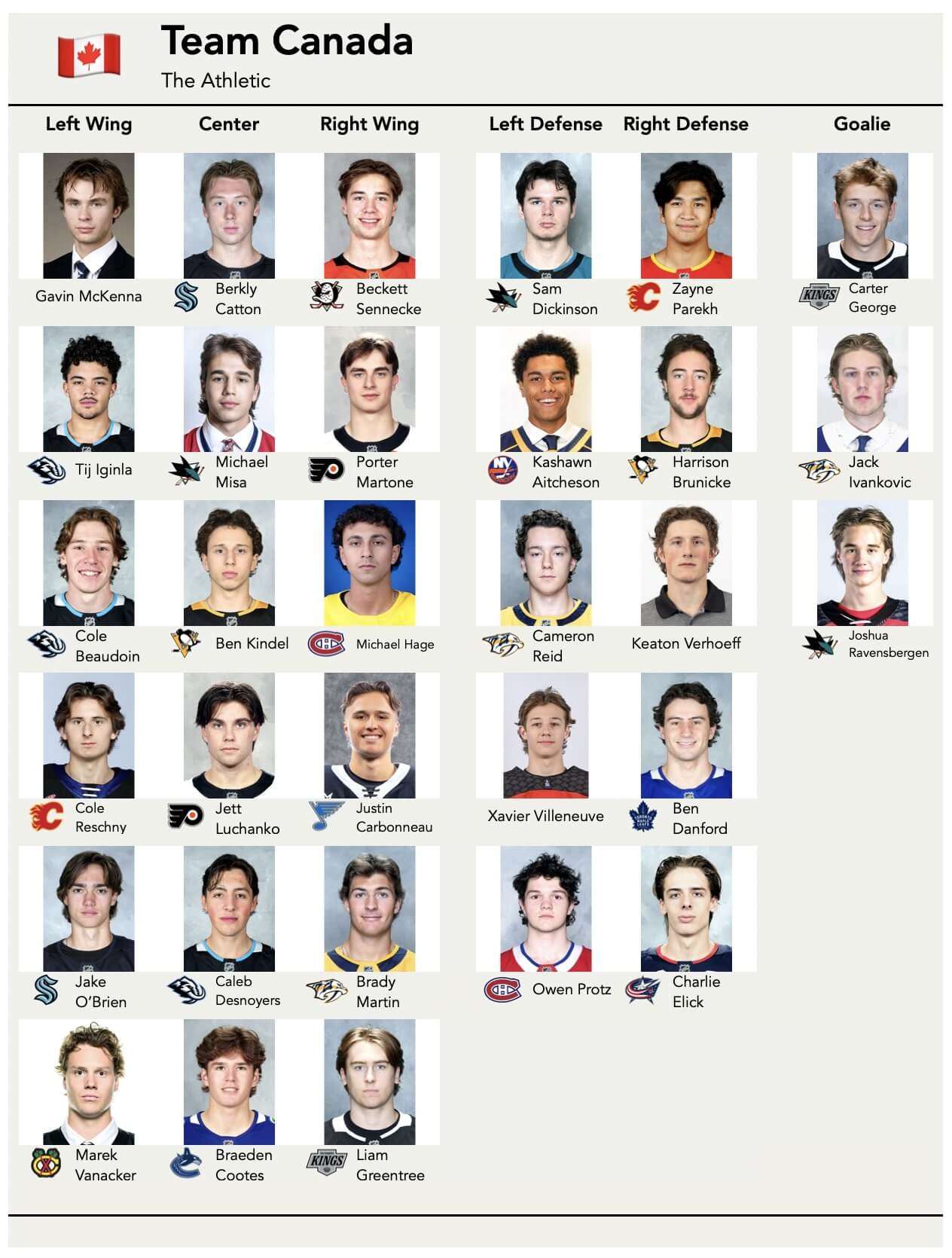On this week’s episode of The Athletic Hockey Show Prospect Series, Corey Pronman, Scott Wheeler, Max Bultman and Chris Peters hosted a mock meeting to build Team Canada and Team USA rosters for the 2026 World Juniors.
The roster debates for Team Canada are always both contentious and, until they get word on their NHL guys, tricky to build out. For now, our committee decided to build out the depth chart with all seven non-Macklin Celebrini/Matthew Schaefer NHL bodies.
But to plan for the inevitability that they won’t get all of them (it sounds like Beckett Sennecke is expected to stay in Anaheim, for example), we tasked ourselves with building out a depth chart of 18 forwards and 10 defensemen to account for the different contingency plans their brass must consider.
The projected depth chart
Based on our discussion, here’s how we see Team Canada lining up in Minnesota:
The starting point
After each of our four panelists submitted their own rosters, a list of agreed-upon players began to take shape. Up front, the NHLers, Porter Martone and Gavin McKenna were predictably unanimous. But so too were Michael Hage, Tij Iginla, returnee Cole Beaudoin and, after a little debate, returnee Jett Luchanko. If they were to somehow get all of their NHL players back, that very quickly meant that there were 10 forward spots accounted for.
On the back end, our panel also had a shared top-four: the three NHLers and Islanders first-rounder Kashawn Aitcheson as their next left-shot.
In net, the three goalies were also agreed upon and we ultimately settled on last year’s starter Carter George (who also led this group to gold at U18 worlds) as the Boxing Day starter again — with some caveats about getting Jack Ivankovic, whose Hockey Canada pedigree is also sterling and who’s off to an excellent start as a freshman at Michigan, getting a fair look before the quarterfinals. For all the talk of Canadian goaltenders, they should have the best tandem in this year’s tournament.
A deep bench up front
With just eight of our 18 forward spots in essence up for grabs, our panel ultimately decided that U18 worlds standouts Cole Reschny, Brady Martin and Braeden Cootes belonged (about in that order), and that winger Justin Carbonneau’s combination of size, physicality, skill and scoring warranted inclusion.
Marek Vanacker also fits as a big, strong, fast, forechecking, dirty areas go-getter who could fit as a bottom-sixer on this roster if they don’t get some of their NHLers — and maybe even if they do.
Though Liam Greentree’s lackluster U18 worlds and lack of pace at times will loom as Canada makes its decisions, he’s a big forward, a captain on a top team, and finished third in the OHL in scoring last year, and we ultimately felt he should be in the mix as well.
The two most highly debated forward inclusions were 18-year-old Mammoth top-five pick Caleb Desnoyers and Kraken top-10 pick Jake O’Brien, who are both eligible for the 2027 team as well. Desnoyers hasn’t played much after undergoing offseason wrist surgery, and hasn’t yet found his level. And while O’Brien currently leads the OHL in scoring as the captain of the best team in the CHL, our panel wondered about his fit for this year, given that the top-six jobs and power play units are accounted for, and Hockey Canada hasn’t typically used him as a checker. If Catton, Misa, Kindel and Sennecke were all not loaned to the team, O’Brien would become a more natural option.
How about that depth, though?
Worry about the left side of the defense
If Canada’s roster is susceptible anywhere, the most likely spot is on the left side of its defense. The Flames have committed to loaning righty Zayne Parekh, and while the Penguins may be less inclined to loan their two players if they continue to hold onto a playoff spot, Harrison Brunicke’s had some off games and will want to be a part of it after missing last year’s tournament due to a last-minute injury. Top 2026 prospect Keaton Verhoeff and the ever-reliable, penalty-killing, shot-blocking Ben Danford give them good depth on the right side as well.
But if the Sharks don’t loan Sam Dickinson, our panel felt uneasy about the left side after Aitcheson. We ultimately agreed that Preds first-rounder Cameron Reid should be in the top six, but they didn’t really like the idea of Xavier Villeneuve as more than a No. 7 PPQB and Owen Protz as more than a No. 7 PKer. There was some support for Blue Jackets first-rounder Jackson Smith as well, but the panel was divided on his season at Penn State (Wheeler has liked him, Peters and Pronman less so).
The final cuts
Even going six lines deep, there were some big names left off our depth chart, including two recent top-10 picks in Cayden Lindstrom (Blue Jackets) and Roger McQueen (Ducks). McQueen wasn’t on any of our rosters, and Lindstrom appeared only on Pronman’s.
Blackhawks first-rounder Sacha Boisvert also appeared on two of our panels’ rosters but lost out in final voting to other bubble guys like O’Brien, Desnoyers, Vanacker, Cootes and Greentree. And our group felt Lightning prospect Sam O’Reilly (who plays under Team Canada head coach Dale Hunter and management group member Mark Hunter in London) should be just on the outs given their depth at center. (Natural centers like Beaudoin, Reschny, O’Brien and Martin have already been moved to the wing on our roster.)
Summary
If Canada gets five or six of the seven NHLers we included in the depth chart, they’re going to be heavy favorites at this year’s tournament. If they get just one or two, which is a real possibility, they should still be favorites but could suddenly be a little more vulnerable, especially if they don’t get one or both of Dickinson and Brunicke, who they’ll need to eat minutes.


